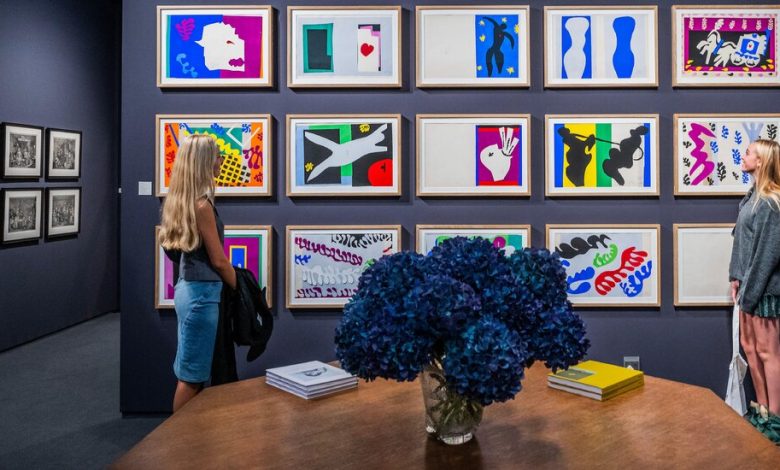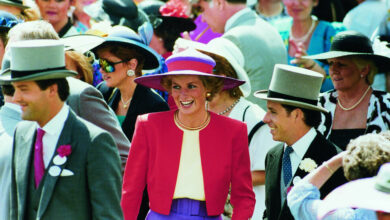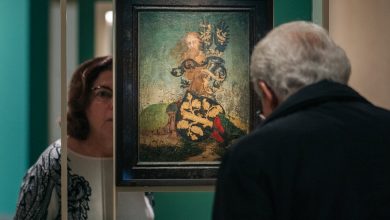At 20, Frieze London Is a Different Fair for a Changed City

The patch of park is the same. The design of the tent is similar and the people inside look familiar. But since it opened in 2003, a lot has changed at the Frieze London art fair, whose 20th anniversary edition opened to V.I.P. visitors on Wednesday. London is different, too. And the world isn’t the same, either.
Frieze’s first edition “was really exciting — there was a lot of buzz,” said the London-based dealer Alison Jacques. She was one of the 124 contemporary gallerists who participated in the 2003 event, which drew 27,700 visitors, and has been exhibiting at the fair ever since.
Jacques said London’s contemporary art scene was small and parochial at the time, with just a handful of collectors, until the Frieze magazine founders Amanda Sharpe and Matthew Slotover came up with the idea for the fair.
In 2023, it is a very different, and much bigger, beast. The exhibitor list is longer (167 this year) and the price points are far higher. Annual attendance in recent years topped 100,000. And Frieze London is just one part of a chain of Frieze fairs, with other editions in New York, Los Angeles and Seoul. (Frieze is now owned by the Hollywood-based entertainment behemoth Endeavor.)
Since 2012, the London edition has also featured the elegant Frieze Masters, a sister fair also held in Regent’s Park. Following the demise of the summer Masterpiece fair, this is now the only London event for dealers to offer top quality pre-21st century pieces to an international audience.
Frieze London itself is, more than ever, about commerce, and the quirky moments that defined earlier editions have gone. Conceptual stunts like the pile of odorless excrement that the Japanese artist Noritoshi Hirakawa exhibited at Frieze in 2004 have faded from memory.
Instead we have paintings. Lots and lots of paintings.
On Wednesday, Gagosian presented a fresh series of gloopy, large-scale canvases by Damien Hirst. In recent years, the enfant terrible of formaldehyde taxidermy has concentrated on making monumental series of thickly impastoed canvases that have proved a hit in a market increasingly dominated by decorative flat art.
His 12 new riotously colored “Secret Gardens Paintings” had all found buyers before the fair, priced between $450,000 and $1 million, according to collectors and advisers who inquired at the booth.
Tracey Emin, another “Young British Artist” who shot to fame around the same time as Hirst, now also concentrates on painting. Presenting one of her violently expressionist canvases has become almost obligatory for a White Cube booth at any major international fair. Here at Frieze London, the 2022 acrylic, “I Kept Moving,” sold for 1.2 million pounds, or about $1.5 million, White Cube said in a statement.
“Frieze has gone soft, but it still manages to serve as a viable sales platform for galleries that want to reach an international crowd,” said Wendy Cromwell, a New York-based art adviser. “The formula works.”
London might still attract huge quantities of international wealth — 63 billionaires are resident there, the most of any city in Europe, according to Forbes — but Britain’s 2016 vote to leave the European Union has made London a more challenging city to live and work in.
“London has changed,” said the British collector Josh Rose, who left Britain for Monaco soon after the Brexit vote. “I wanted more quality of life — and security,” Rose said, adding that he now had concerns about street crime in the capital.
But with so much international wealth still invested in, or passing through, London, some dealers at Frieze Masters still hoped for multimillion-dollar sales. The Geneva-based old master paintings dealer Salomon Lilian, for instance, was showing a 1635 Frans Hals “Portrait of a Man,” priced at 10 million euros, about $10.5 million.
“It is a ‘lucky shot’ fair. You never know if you’re going to sell it or not,” said Lilian.
Other outstanding exhibits at Frieze Masters included the early Rembrandt painting, “Blind Tobit with the Return of Tobias,” offered by the Zurich dealer David Koetser at $30 million; a wooden Madonna and Child by the 15th-century German sculptor, Tilman Riemenschneider, with a $5 million asking price from London dealer Sam Fogg; and the final proofs of Henry Matisse’s famous 1947 “Jazz” print portfolio, at $10 million on the booth of London-based Lyndsey Ingram.
By end of day Thursday, none of these mega-ticket items had found buyers.
Wealthy collectors are spoiled for choice when they come to London for so-called “Frieze Week.” In addition to the fairs, there are also satellite attractions like the PAD London design fair and the 1-54 Contemporary African Art Fair, as well as auctions at Sotheby’s, Christie’s and Phillips.
But the one thing the London market has been lacking is a compelling independent fair for younger galleries and artists, where collectors can discover fresh talent. This year the gap was addressed by Minor Attractions, a nonprofit founded by the London dealers Jonny Tanna and Jacob Barnes, which held two small, scrappy selling exhibitions.
One of those, “Cornershop,” billed as a “true hub for activity outside of Frieze, by London, for London,” occupied a difficult-to-find refurbished railway arch near London Bridge train station. It showcased more than 30 artists represented by 18 younger dealerships. The center of the gallery was dominated by a column embedded with sculptures by artists from a South London group called Collective Ending. Unfortunately, on a drizzly Thursday afternoon, there was no information available in the all-but-deserted gallery about which sculpture was by which artist, or the prices.
“This is a start,” said Jarelle Francis, a curator and gallerist who was staffing “Cornershop” that afternoon. Francis, who runs Meadow, a South London performance art space, graduated recently from the Royal College of Art with a dissertation titled “How to Live in an Unliveable City.” He said few of his cohort of more than 40 curatorial graduates had found a job in the art world, adding that, because of the onerous expense of living in the British capital, “others who have found work had to leave London, or the country.”
Twenty years after the first Frieze fair, with Paris and other European cities looking like increasingly attractive destinations both for artists and collectors, London could do with all the fresh starts it can get.





